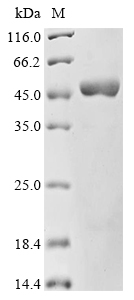Recombinant Streptococcus pyogenes UDP-glucose 6-dehydrogenase (hasB)
CAT:
399-CSB-EP025567SMR-02
Size:
100 µg
Price:
Ask
- Availability: 24/48H Stock Items & 2 to 6 Weeks non Stock Items.
- Dry Ice Shipment: No




Recombinant Streptococcus pyogenes UDP-glucose 6-dehydrogenase (hasB)
- CAS Number: 9000-83-3
- Gene Name: hasB
- UniProt: P0C0F4
- Expression Region: 1-402aa
- Organism: Streptococcus pyogenes
- Target Sequence: MKIAVAGSGYVGLSLGVLLSLQNEVTIVDILPSKVDKINNGLSPIQDEYIEYYLKSKQLSIKATLDSKAAYKEAELVIIATPTNYNSRINYFDTQHVETVIKEVLSVNSHATLIIKSTIPIGFITEMRQKFQTDRIIFSPEFLRESKALYDNLYPSRIIVSCEENDSPKVKADAEKFALLLKSAAKKNNVPVLIMGASEAEAVKLFANTYLALRVAYFNELDTYAESRKLNSHMIIQGISYDDRIGMHYNNPSFGYGGYCLPKDTKQLLANYNNIPQTLIEAIVSSNNVRKSYIAKQIINVLKEQESPVKVVGVYRLIMKSNSDNFRESAIKDVIDILKSKDIKIIIYEPMLNKLESEDQSVLVNDLENFKKQANIIVTNRYDNELQDVKNKVYSRDIFGRD
- Tag: N-terminal 10xHis-tagged and C-terminal Myc-tagged
- Source: E.coli
- Field of Research: Cell Biology
- Assay Type: Developed Protein
- Relevance: Catalyzes the formation of UDP-glucuronic acid which is required for capsular hyaluronic acid synthesis.
- Purity: Greater than 85% as determined by SDS-PAGE.
- Activity: Not Test
- Length: Full Length
- Form: Liquid or Lyophilized powder
- Buffer: If the delivery form is liquid, the default storage buffer is Tris/PBS-based buffer, 5%-50% glycerol. If the delivery form is lyophilized powder, the buffer before lyophilization is Tris/PBS-based buffer, 6% Trehalose, pH 8.0.
- Reconstitution: We recommend that this vial be briefly centrifuged prior to opening to bring the contents to the bottom. Please reconstitute protein in deionized sterile water to a concentration of 0.1-1.0 mg/mL.We recommend to add 5-50% of glycerol (final concentration) and aliquot for long-term storage at -20℃/-80℃. Our default final concentration of glycerol is 50%. Customers could use it as reference.
- Molecular Weight: 52.9 kDa
- References & Citations: "Molecular characterization of hasB from an operon required for hyaluronic acid synthesis in group A streptococci. Demonstration of UDP-glucose dehydrogenase activity." Dougherty B.A., van de Rijn I. J. Biol. Chem. 268:7118-7124 (1993)
- Storage Conditions: The shelf life is related to many factors, storage state, buffer ingredients, storage temperature and the stability of the protein itself. Generally, the shelf life of liquid form is 6 months at -20℃/-80℃. The shelf life of lyophilized form is 12 months at -20℃/-80℃.
